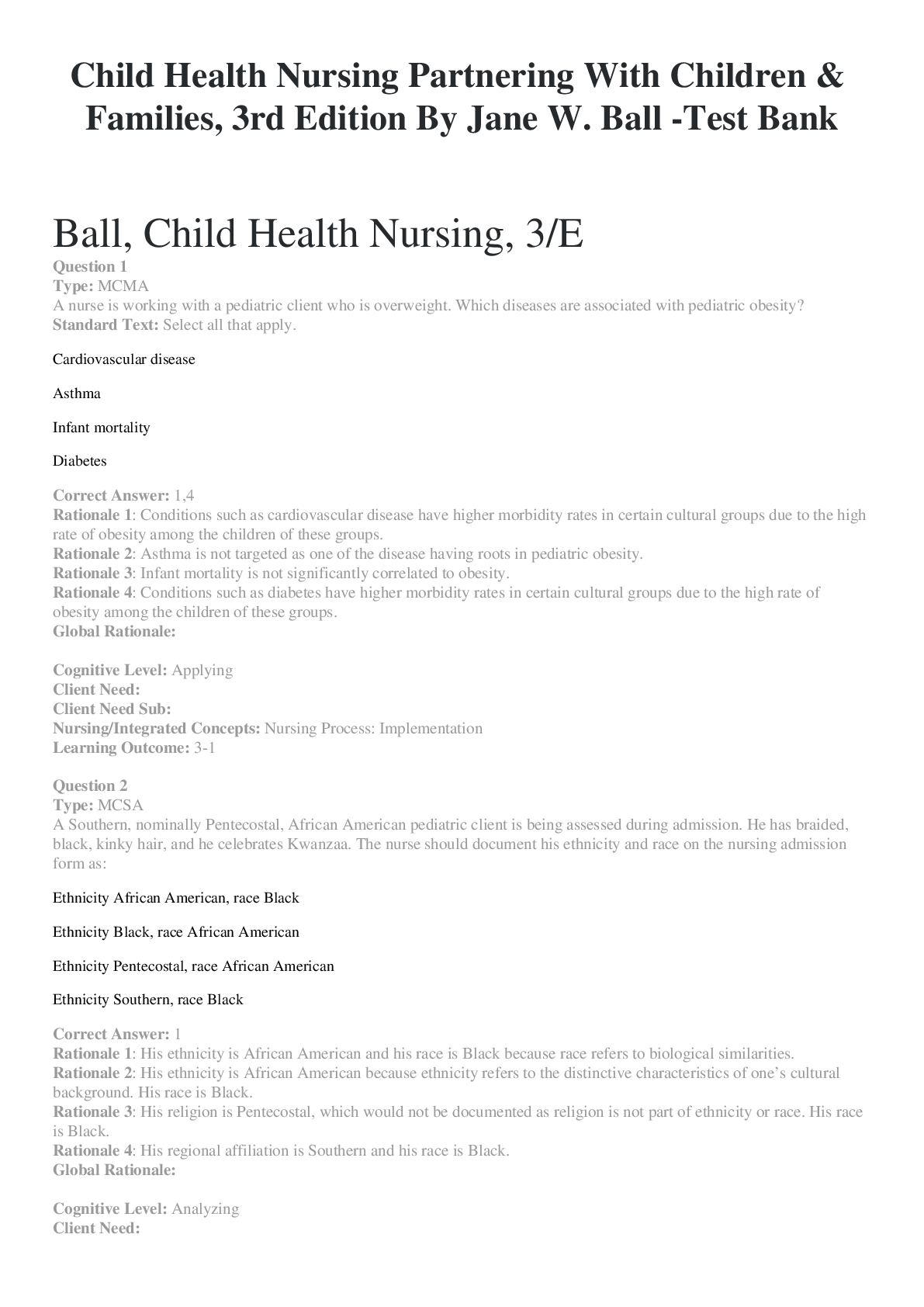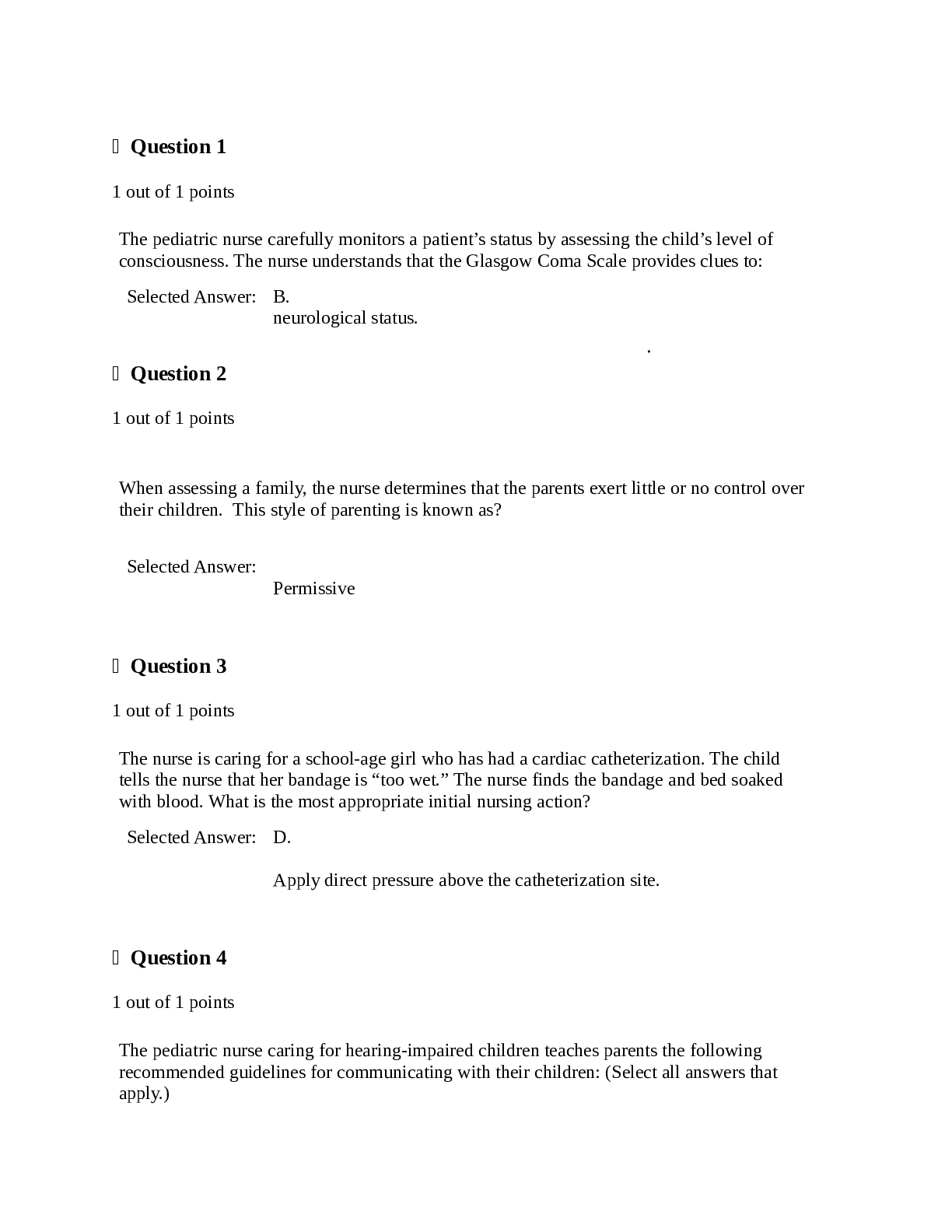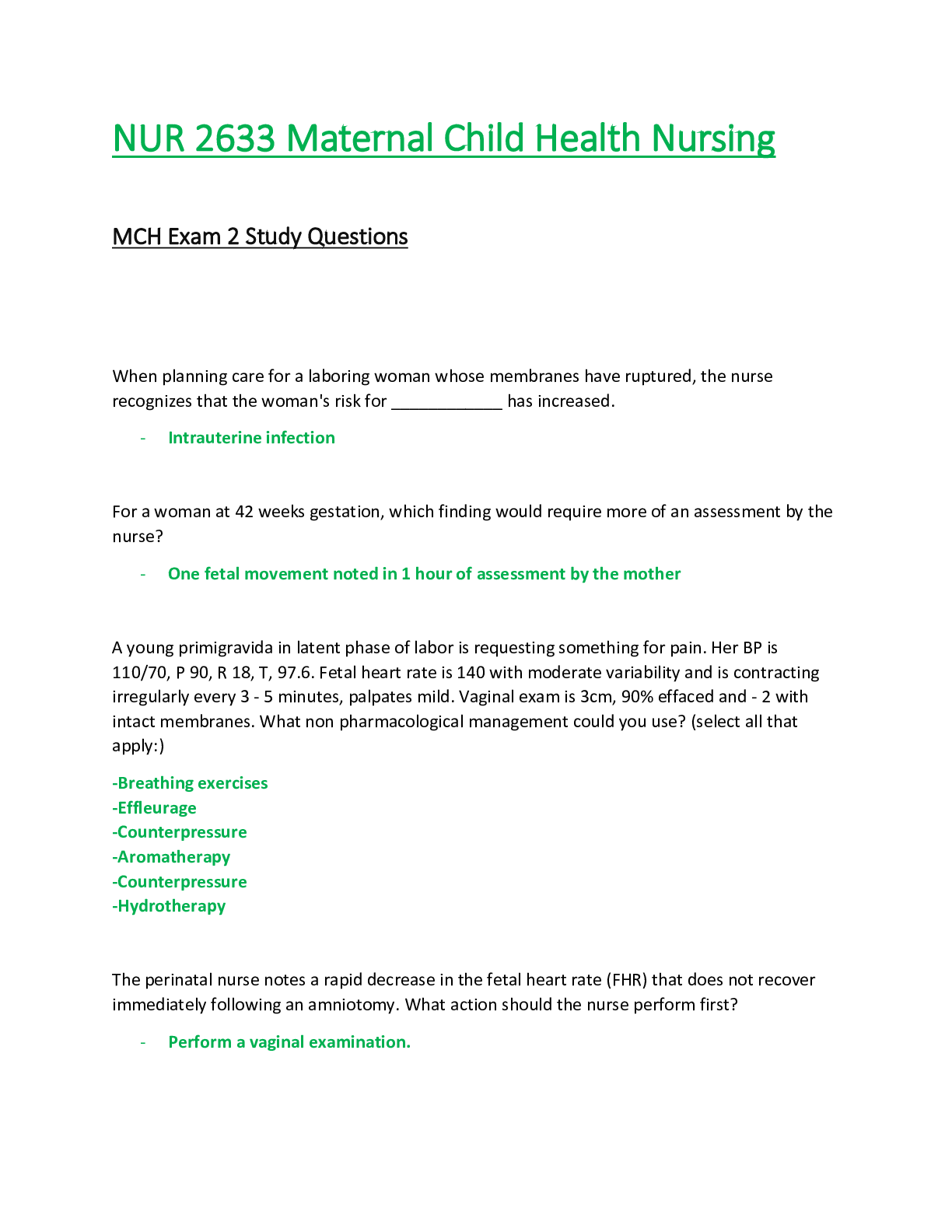Obstetrics > EXAM > Maternal and Child Health Nursing Graded A+ (All)
Maternal and Child Health Nursing Graded A+
Document Content and Description Below
A postpartum patient was in labor for 30 hours and had ruptured membranes for 24 hours. For which of the following would the nurse be alert? A. Endometritis B. Endometriosis C. Salpingitis D. Pelv... ic thrombophlebitis - ANSWER A. Endometritis Rationale: Endometritis is an infection of the uterine lining and can occur after prolonged rupture of membranes. A client at 36 weeks gestation is schedule for a routine ultrasound prior to an amniocentesis. After teaching the client about the purpose for the ultrasound, which of the following client statements would indicate to the nurse in charge that the client needs further instruction? A. The ultrasound will help to locate the placenta B. The ultrasound identifies blood flow through the umbilical cord C. The test will determine where to insert the needle D. The ultrasound locates a pool of amniotic fluid - ANSWER B. The ultrasound identifies blood flow through the umbilical cord. Rationale: Before amniocentesis, a routine ultrasound is valuable in locating the placenta, locating a pool of amniotic fluid, and showing the physician where to insert the needle. Color Doppler imaging ultrasonography identifies blood flow through the umbilical cord. A routine ultrasound does not accomplish this. While the postpartum client is receiving heparin for thrombophlebitis, which of the following drugs would the nurse expect to administer if the client develops complications related to heparin therapy? - ANSWER Protamine Sulfate Rationale: Protamine sulfate is a heparin antagonist given intravenously to counteract bleeding complications caused by heparin overdose. When caring for a 3-day-old neonate who is receiving phototherapy to treat jaundice, the nurse in charge would expect to do which of the following? - ANSWER Check the vital signs every 2 to 4 hours. Rationale: While caring for an infant receiving phototherapy for Tx. of jaundice, vital signs are checked every 2 to 4 hours because hyperthermia can occur due to the phototherapy lights. A primigravida in active labor is about 9 days post-term. The client desires a bilateral pudendal block anesthesia before delivery. After the nurse explains this type of anesthesia to the client, which of the following locations identified by the client as the area of relief would indicate to the nurse that the teaching was effective? - ANSWER Perineum Rationale: A bilateral pudendal block is used for vaginal deliveries to relieve pain primarily in the perineum and vagina. Pudendal block anesthesia is adequate for episiotomy and its repair. The nurse is caring for a primigravida at about 2 months and 1 week gestation. After explaining self-care measures for common discomforts of pregnancy, the nurse determines that the client understands the instructions when she says: - ANSWER "Nausea and vomiting can be decreased if I eat a few crackers before arising" Rationale: Eating dry crackers before arising can assist in decreasing the common discomfort of nausea and vomiting. Avoiding strong food odors and eating a high-protein snack before bedtime can also help. Forty eight hours after delivery, the nurse in charge plans discharge teaching for the client about infant care. By this time, the nurse expects that the phase of postpartum psychological adaptation that the client would be in would be termed which of the following? - ANSWER Taking hold Rationale: Beginning after completion of the taking-in phase, the taking hold phase lasts about 10 days. During this phase, the client is concerned with her need to resume control of all facets of her life in a competent manner. At this time, she is ready to learn self-care and infant care skills. A pregnant client is diagnosed with partial placenta previa. In explaining the diagnosis, the nurse tells the client that the usual treatment for partial placenta previa is which of the following? - ANSWER Activity limited to bed rest Rationale: Treatment of partial placenta previa includes bed rest, hydration, and careful monitoring of the client's bleeding. The nurse plans to instruct the postpartum client about methods to prevent breast engorgement. Which of the following measures would the nurse include in the teaching plan? - ANSWER Breast-feeding the neonate at frequent intervals. Rationale: Prevention of breast engorgement is key. The best technique is to empty the breast regularly with feeding. Engorgement is less likely when the mother and neonate are together, as in single room maternity care continuous rooming in, because nursing can be done conveniently to meet the neonate's and mother's needs. When the nurse on duty accidentally bumps the bassinet, the neonate throws out its arms, hands opened, and begins to cry. The nurse interprets this reaction as indicative of which of the following reflexes? - ANSWER Startle reflex Rationale: The Moro, or startle, reflex occurs when the neonate responds to stimuli by extending the arms, hands open, and then moving the arms in an embracing motion. The Moro reflex, present at birth, disappears at about age 3 months. A primigravida client at 25 weeks gestation visits the clinic and tells the nurse that her lower back aches when she arrives home from work. The nurse should suggest that the client perform: - ANSWER Tailor sitting Rationale: Tailor sitting is an excellent exercise that helps to strengthen the client's back muscles and also prepares the client for the process of labor. The client should be encouraged to rest periodically during the day and avoid standing or sitting in one position for a long time. Which of the following would the nurse in charge do first after observing a 2-cm circle of bright red bleeding on the diaper of a neonate who just had a circumcision? - ANSWER Apply gentle pressure to the site with a sterile gauze pad. Rationale: If bleeding occurs after circumcision, the nurse should first apply gentle pressure on the area with sterile gauze. Which of the following would the nurse most likely expect to find when assessing a pregnant client with abruption placenta? - ANSWER Rigid, board like abdomen Rationale: The most common assessment finding in a client with abruption placenta is a rigid or board-like abdomen. Pain, usually reported as a sharp stabbing sensation high in the uterine fundus with the initial separation, also is common. While the client is in active labor with twins and the cervix is 5 cm dilates, the nurse observes contractions occurring at a rate of every 7 to 8 minutes in a 30-minute period. Which of the following would be the nurse's most appropriate action? - ANSWER Notify the physician immediately. Rationale: The nurse should contact the physician immediately because the client is most likely experiencing hypotonic uterine contractions. These contractions tend to be painful but ineffective. The usual treatment is oxytocin augmentation, unless cephalopelvic disproportion exists. A client tells the nurse, "I think my baby likes to hear me talk to him." When discussing neonates and stimulation with sound, which of the following would the nurse include as a means to elicit the best response? - ANSWER High-pitched speech with tonal variations Rationale: Providing stimulation and speaking to neonates is important. Some authorities believe that speech is the most important type of sensory stimulation for a neonate. Neonates respond best to speech with tonal variations and a high-pitched voice. A neonate can hear all sound louder than about 55 decibels. A 31-year-old multipara is admitted to the birthing room after initial examination reveals her cervix to be at 8 cm, completely effaced (100 %), and at 0 station. What phase of labor is she in? - ANSWER Transitional phase Rationale:The transitional phase of labor extends from 8 to 10 cm; it is the shortest but most difficult and intense for the patient. The latent phase extends from 0 to 3 cm; it is mild in nature. The active phase extends from 4 to 7 cm; it is moderate for the patient. The expulsive phase begins immediately after the birth and ends with separation and expulsion of the placenta. A pregnant patient asks the nurse if she can take castor oil for her constipation. How should the nurse respond? - ANSWER "No, it can initiate premature uterine contractions." Castor oil can initiate premature uterine contractions in pregnant women. It also can produce other adverse effects, but it does not promote sodium retention. Castor oils is not known to increase absorption of fat-soluble vitamins, although laxatives in general may decrease absorption if intestinal motility is increased. A patient in her 14th week of pregnancy has presented with abdominal cramping and vaginal bleeding for the past 8 hours. She has passed several cloth. What is the primary nursing diagnosis for this patient? - ANSWER Fluid volume deficit Explanation: If bleeding and clots are excessive, this patient may become hypovolemic. Pad count should be instituted. Although the other diagnoses are applicable to this patient, they are not the primary diagnosis. Immediately after a delivery, the nurse-midwife assesses the neonate's head for signs of molding. Which factors determine the type of molding? - ANSWER Fetal body flexion or extension Explanation: Fetal attitude—the overall degree of body flexion or extension—determines the type of molding in the head a neonate. For a patient in active labor, the nurse-midwife plans to use an internal electronic fetal monitoring (EFM) device. What must occur before the internal EFM can be applied? - ANSWER The membranes must rupture xplanation: Internal EFM can be applied only after the patient's membranes have ruptured, when the fetus is at least at the -1 station, and when the cervix is dilated at least 2 cm. A primigravida patient is admitted to the labor delivery area. Assessment reveals that she is in early part of the first stage of labor. Her pain is likely to be most intense: - ANSWER Around the pelvic girdle Explanation: During most of the first stage of labor, pain centers around the pelvic girdle. A female adult patient is taking a progestin-only oral contraceptive, or mini pill. Progestin use may increase the patient's risk for: - ANSWER Tubal or ectopic pregnancy Explanation: Women taking the minipill have a higher incidence of tubal and ectopic pregnancies, possibly because progestin slows ovum transport through the Fallopian tubes. A patient with pregnancy-induced hypertension probably exhibits which of the following symptoms? - ANSWER Proteinuria, headaches, double vision Explanation: A patient with pregnancy-induced hypertension complains of headache, double vision, and sudden weight gain. A urine specimen reveals proteinuria. Because cervical effacement and dilation are not progressing in a patient in labor,the doctor orders I.V. administration of oxytocin (Pitocin). Why must the nurse monitor the patient's fluid intake and output closely during oxytocin administration? - ANSWER Oxytocin causes water intoxication Explanation: The nurse should monitor fluid intake and output because prolonged oxytocin infusion may cause severe water intoxication, leading to seizures, coma, and death. Five hours after birth, a neonate is transferred to the nursery, where the nurse intervenes to prevent hypothermia. What is a common source of radiant heat loss? - ANSWER Cools incubator walls Explanation: Common source of radiant heat loss includes cool incubator walls and windows. After administering bethanechol to a patient with urine retention, the nurse in charge monitors the patient for adverse effects. Which is most likely to occur? - ANSWER Nausea and Vomiting Explanation: Bethanechol will increase GI motility, which may cause nausea, belching, vomiting, intestinal cramps, and diarrhea. [Show More]
Last updated: 1 year ago
Preview 1 out of 13 pages
Instant download
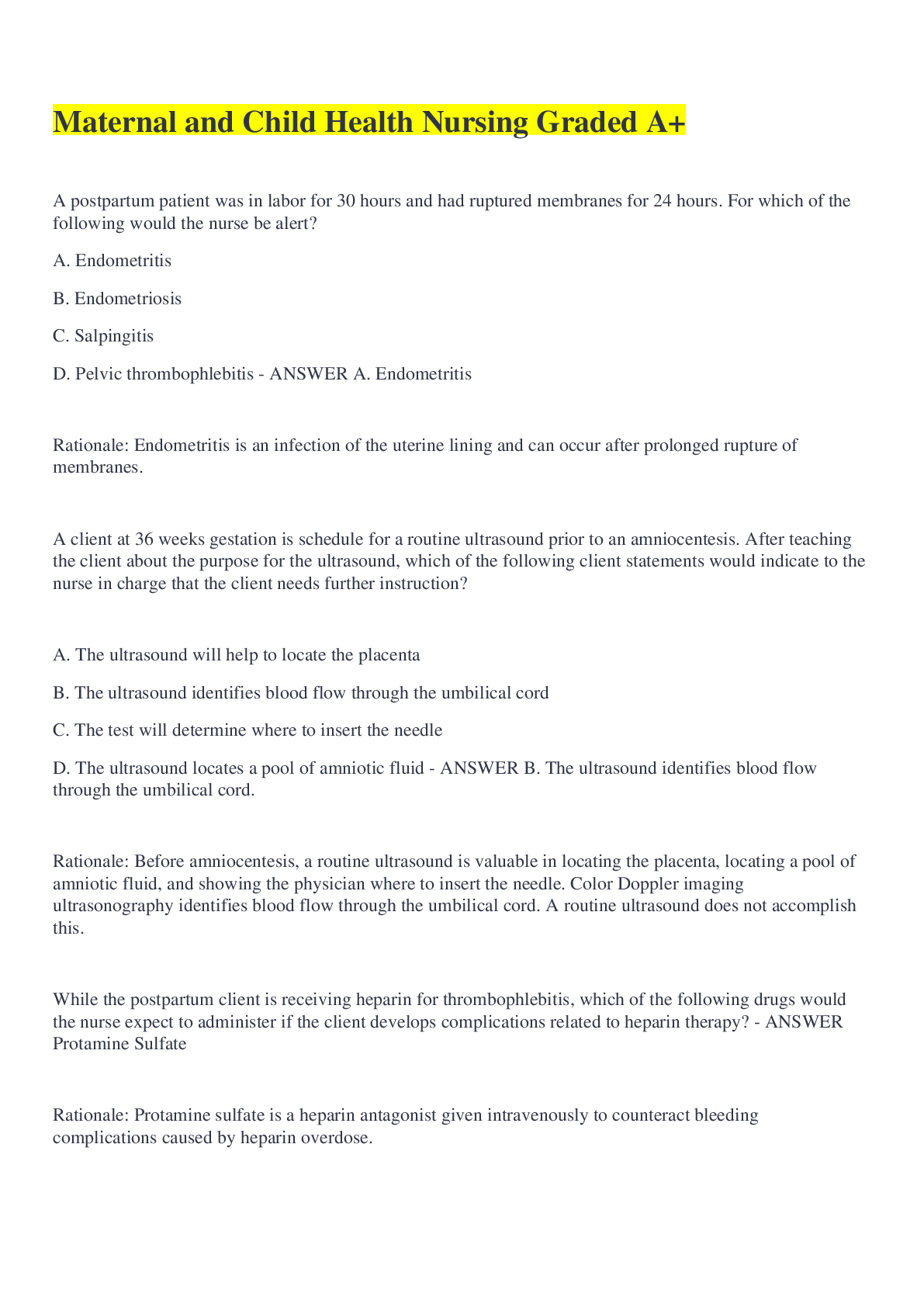
Buy this document to get the full access instantly
Instant Download Access after purchase
Add to cartInstant download
Reviews( 0 )
Document information
Connected school, study & course
About the document
Uploaded On
Sep 25, 2022
Number of pages
13
Written in
Additional information
This document has been written for:
Uploaded
Sep 25, 2022
Downloads
0
Views
62



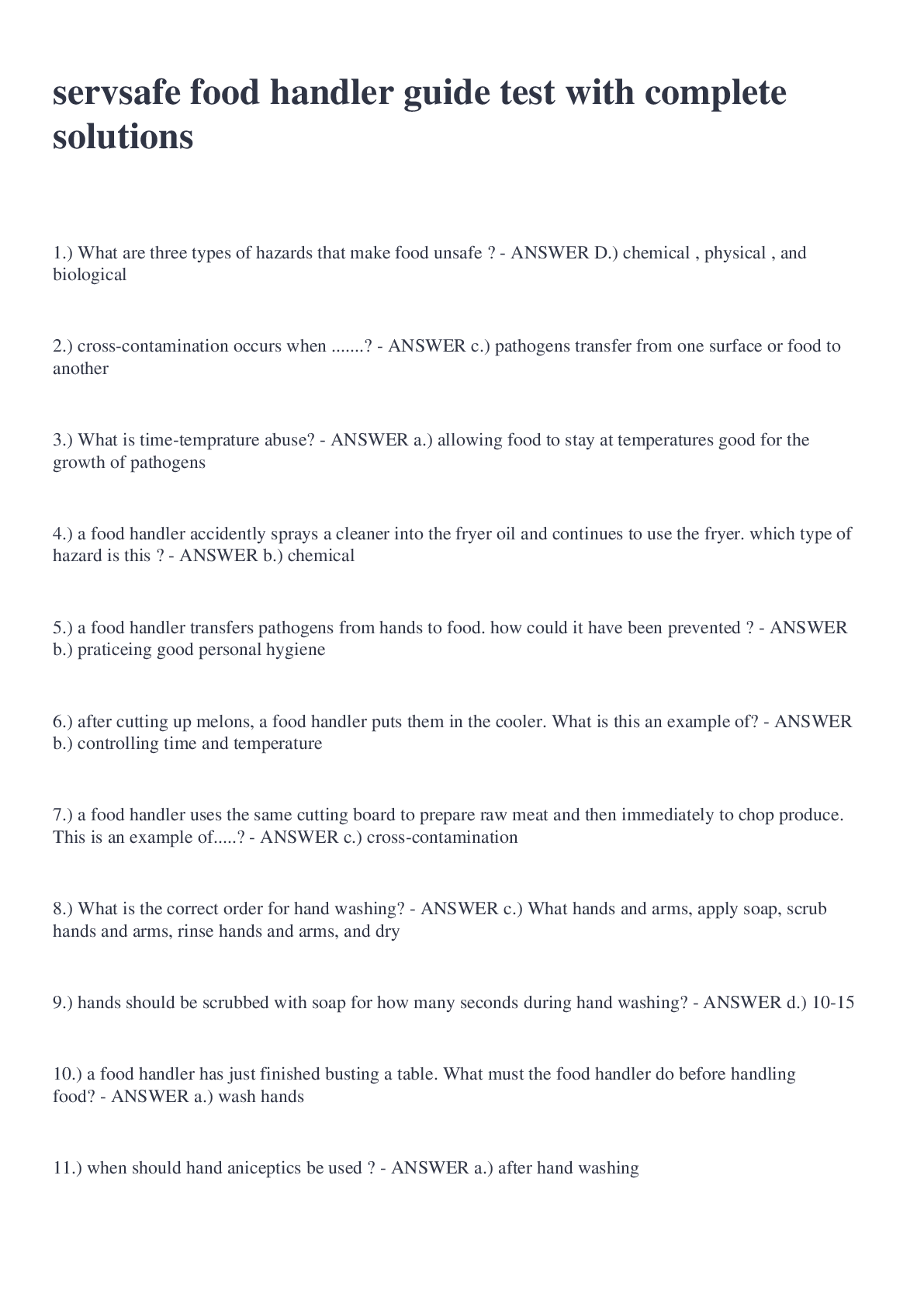


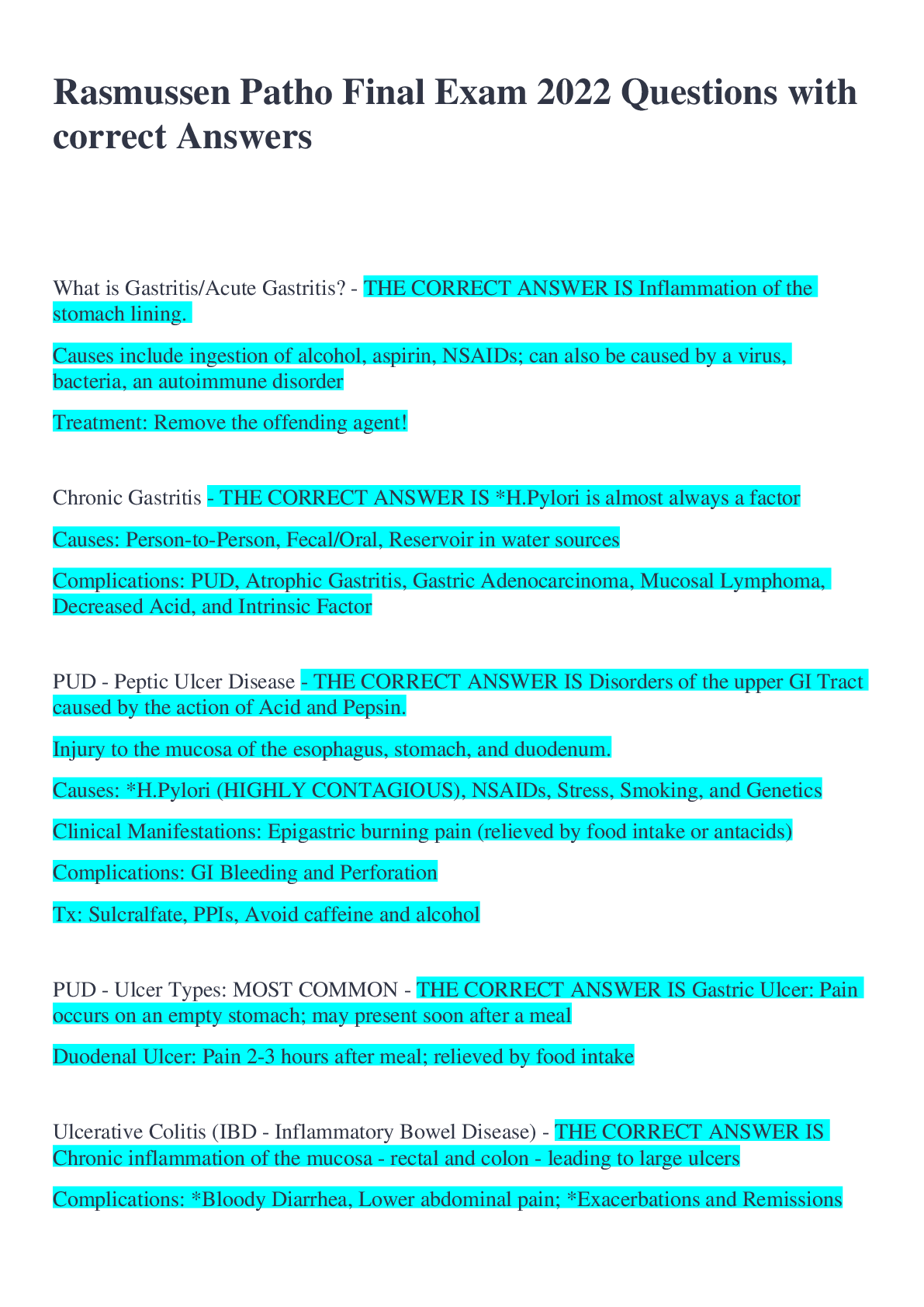
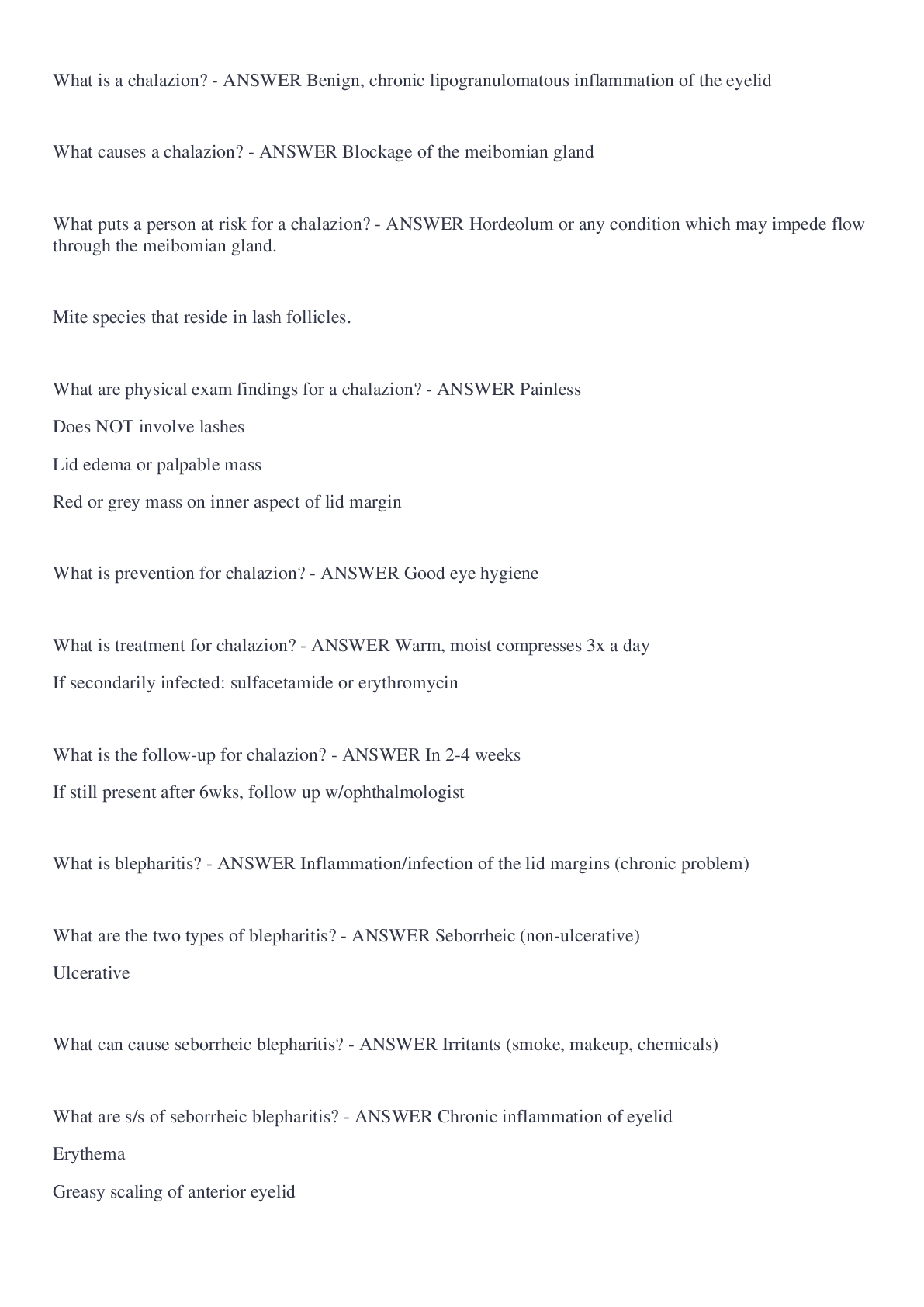
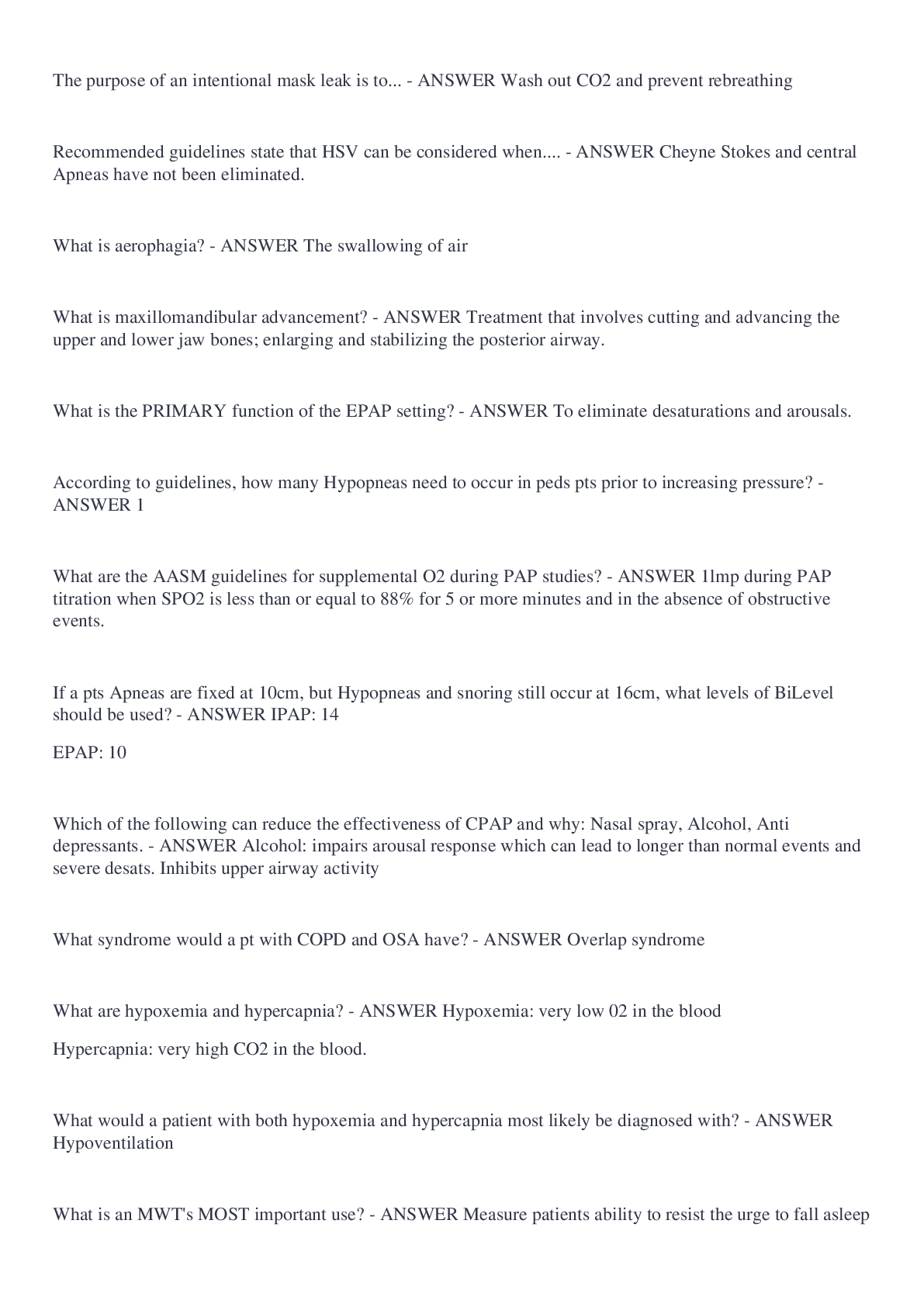




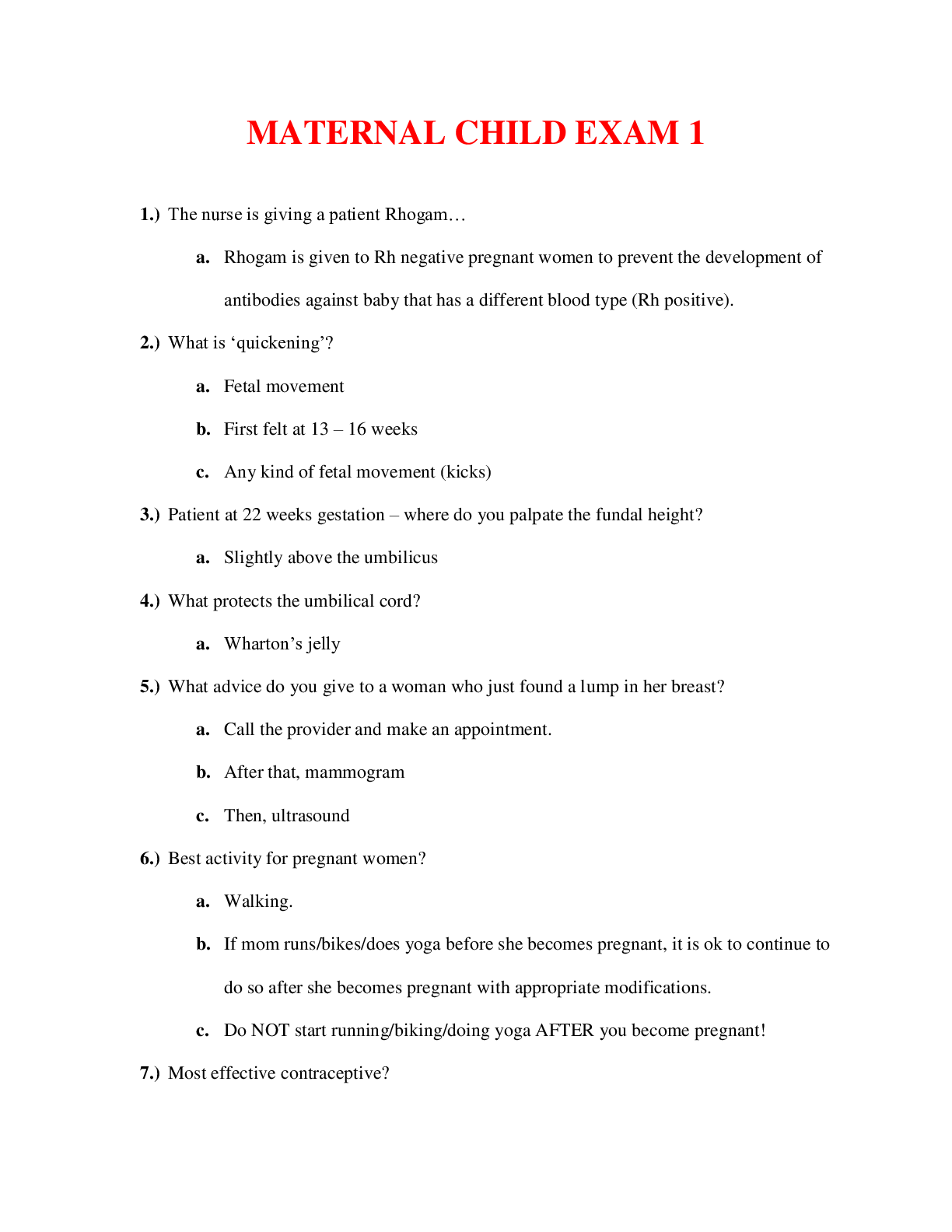
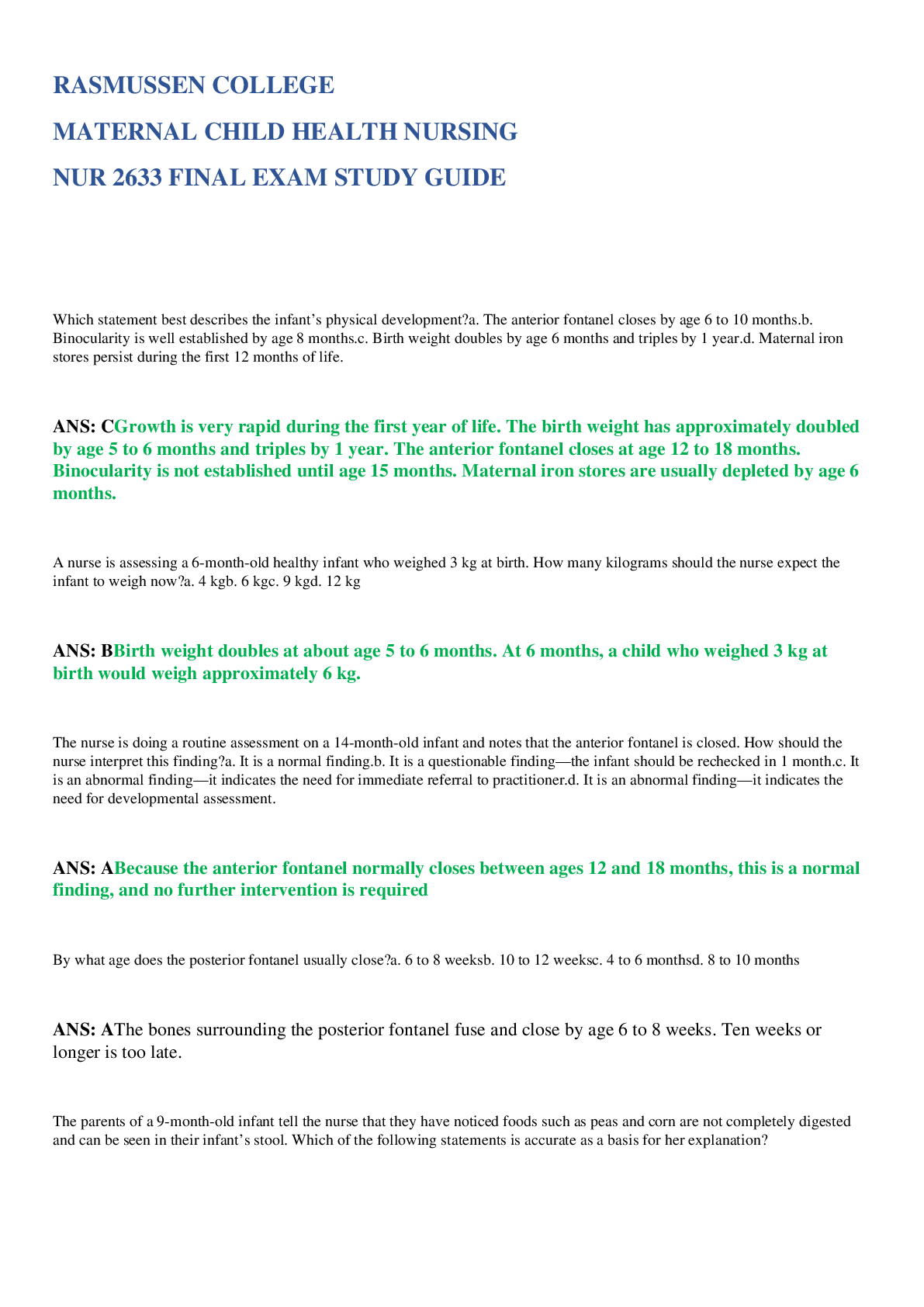
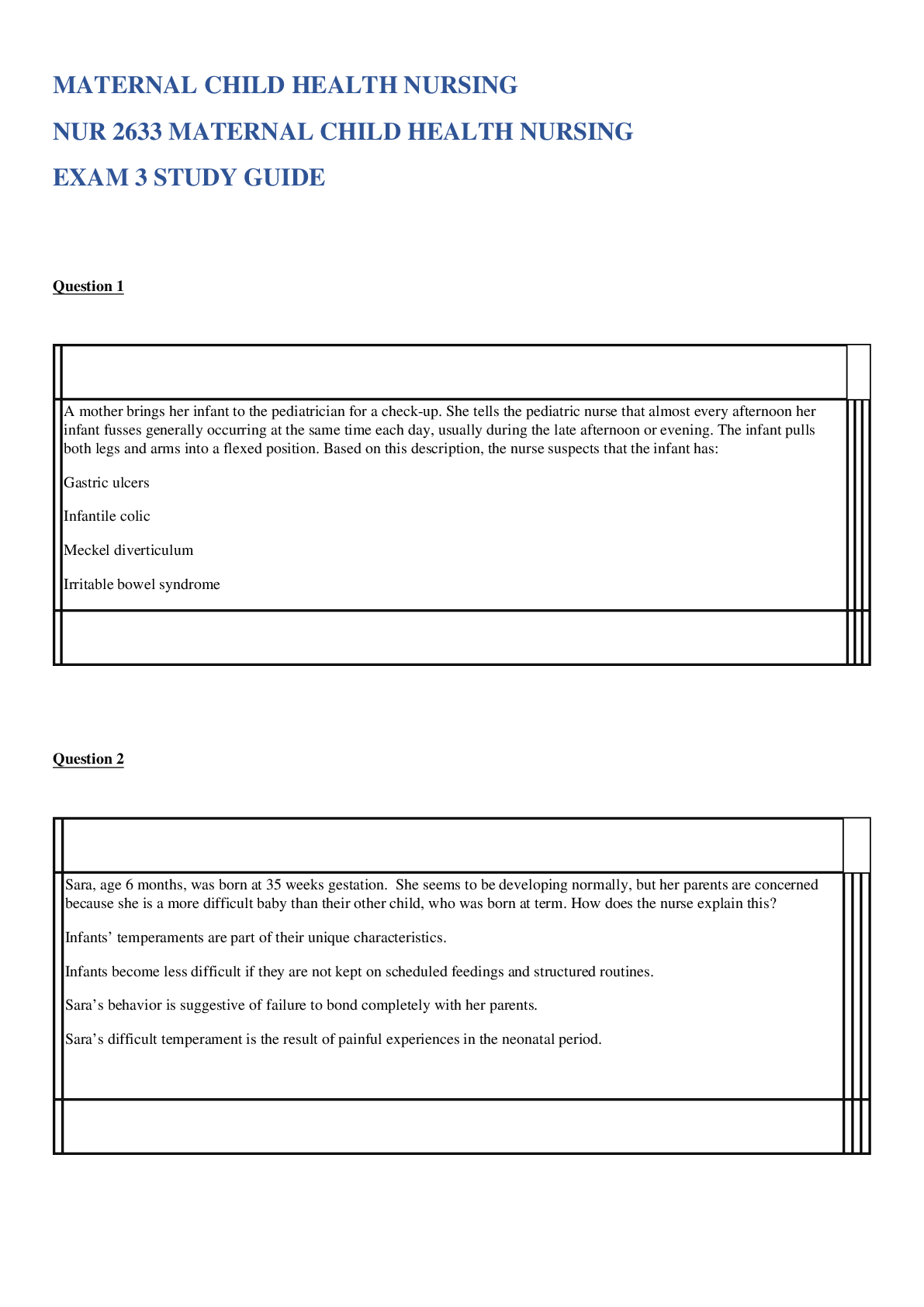

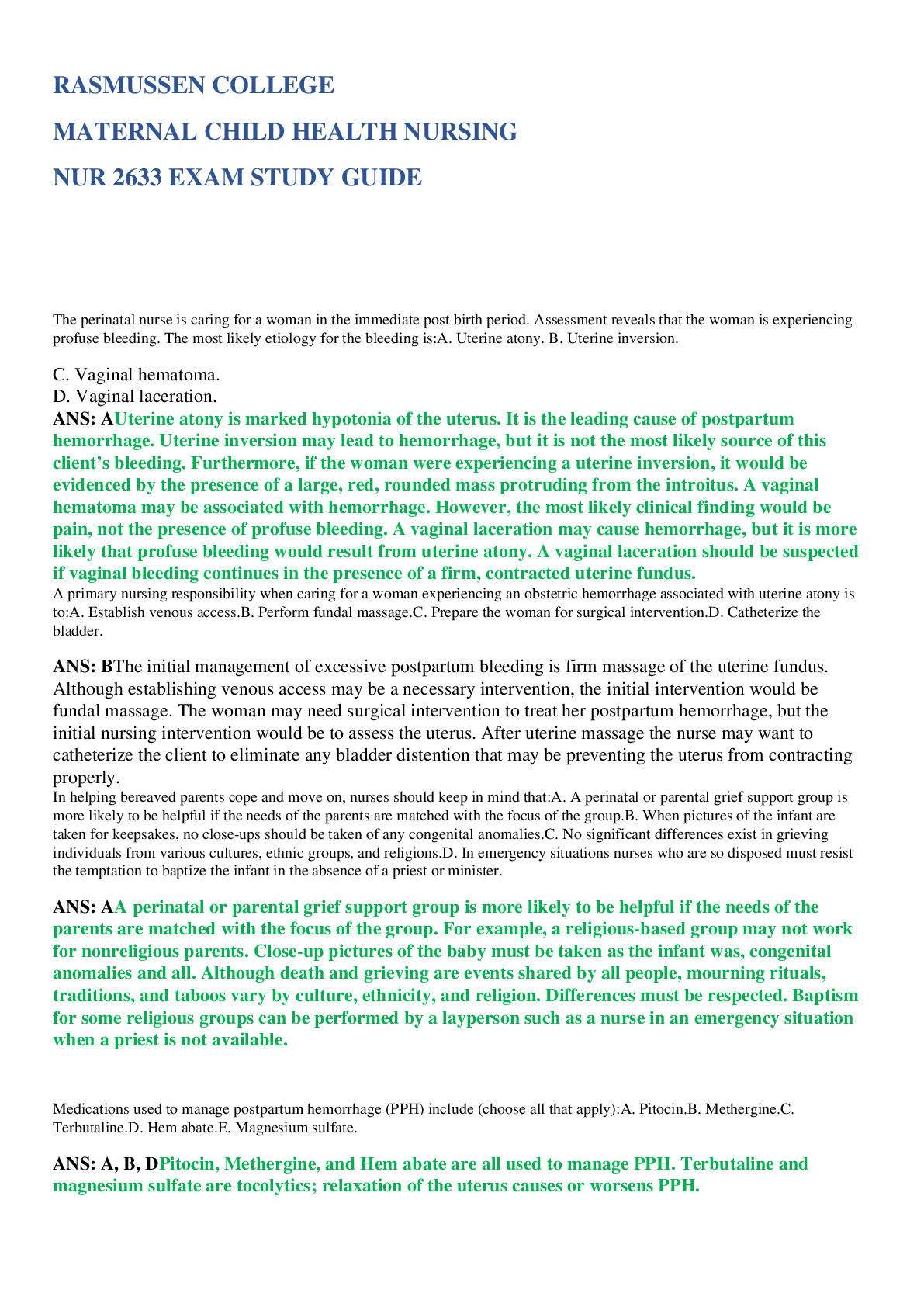
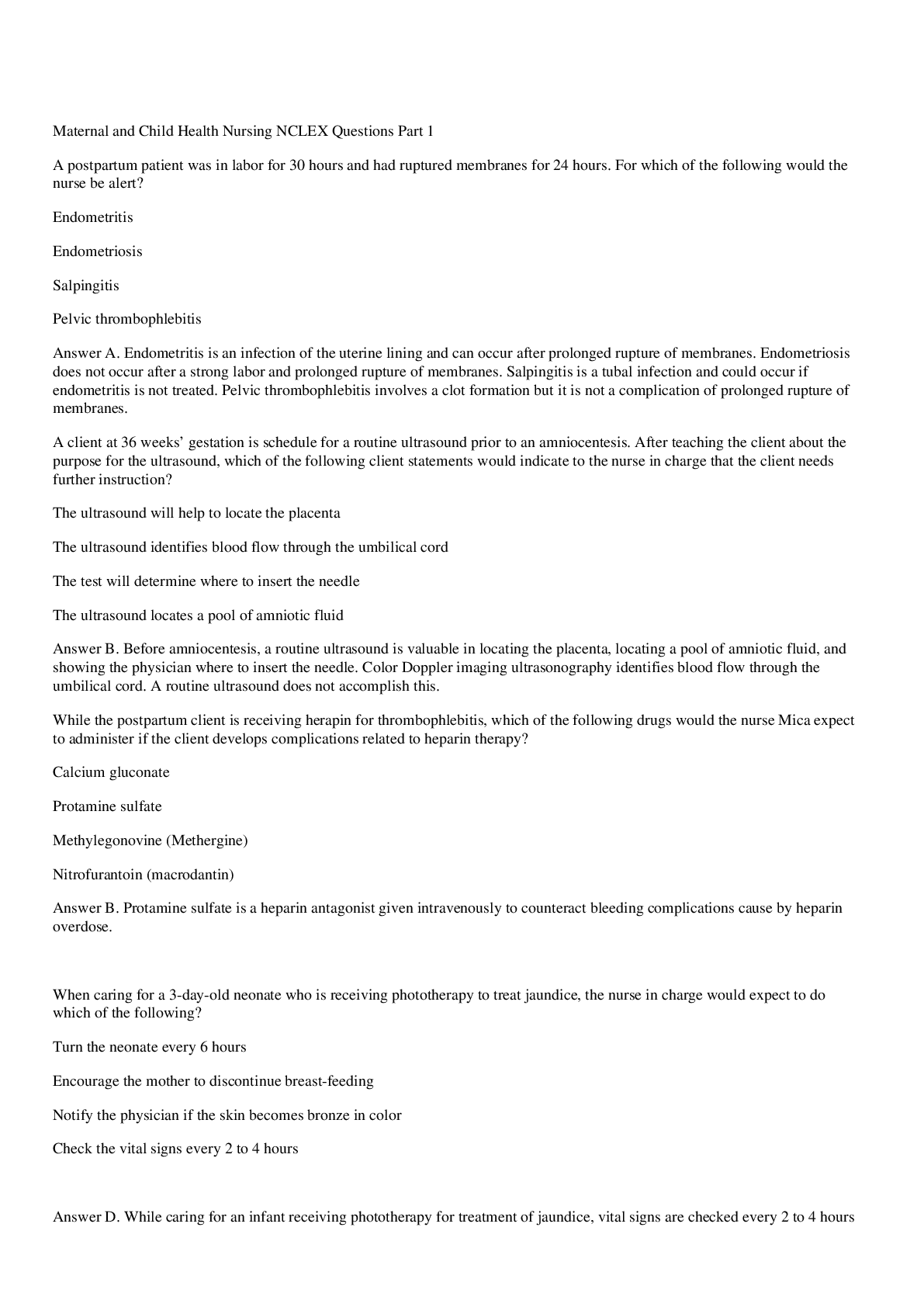
.png)

